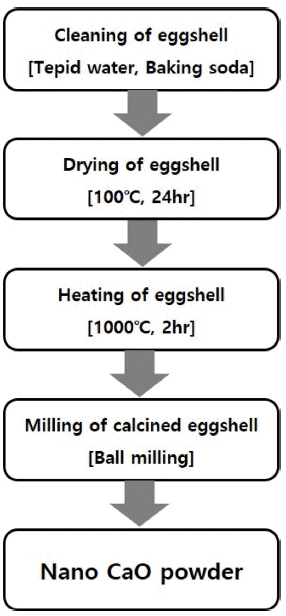Search
- Page Path
- HOME > Search
- [Korean]
- Synthesis of C3S, C2S, C3A Powders using Ultra-fine Calcium Oxide Powder Synthesized from Eggshell and Effect of C3A Content on Hardened Mixed Aggregates
- Heon Kong, Ki-Beom Kwon, Sang-Jin Park, Whyo-Sub Noh, Sang-Jin Lee
- J Korean Powder Metall Inst. 2019;26(6):493-501. Published online December 1, 2019
- DOI: https://doi.org/10.4150/KPMI.2019.26.6.493

- 295 View
- 7 Download
-
 Abstract
Abstract
 PDF
PDF In this work, ultra-fine calcium oxide (CaO) powder derived from eggshells is used as the starting material to synthesize mineral trioxide aggregate (MTA). The prepared CaO powder is confirmed to have an average particle size of 500 nm. MTAs are synthesized with three types of fine CaO-based powders, namely, tricalcium silicate (C3S), dicalcium silicate (C2S), and tricalcium aluminate (C3A). The synthesis behavior of C3S, C2S and C3A with ultra-fine CaO powder and the effects of C3A content and curing time on the properties of MTA are investigated. The characteristics of the synthesized MTA powders are examined by X-ray diffraction (XRD), field emission-scanning electron microscope (FE-SEM), and a universal testing machine (UTM). The microstructure and compressive strength characteristics of the synthesized MTA powders are strongly dependent on the C3A wt.% and curing time. Furthermore, MTA with 5 wt.% C3A is found to increase the compressive strength and shorten the curing time.
- [Korean]
- Russian Mineral Market Flow and Economic Direction for Securing Stable Resources
- Nu Si A Eom, Su Noh, Muhammad Aneeq Haq, Bin Lee, Kyoung Mook Lim, Bum Sung Kim
- J Korean Powder Metall Inst. 2019;26(4):345-349. Published online August 1, 2019
- DOI: https://doi.org/10.4150/KPMI.2019.26.4.345

- 291 View
- 1 Download
-
 Abstract
Abstract
 PDF
PDF With increasing demand for resources worldwide, Korea has been negotiating with resource-holding countries to achieve conservation of energy resources. Among them, Russia is the third largest resource-producing and exporting nation in the world and has several resource materials such as nickel, platinum group metals, gold, and other reserves. As a result, there is growing interest in cooperation between Korea and Russia. The aim of this article is to summarize the current status of market flow of Russian energy resources as well as Russia’s economic cooperation with Korea. Notably, South Korea needs to focus on investing in overseas mines for a stable supply of rare metals. Nevertheless, securing rare metals is a major task by understanding the flow and policy direction of Russian material mines.
TOP
 kpmi
kpmi

 First
First Prev
Prev


